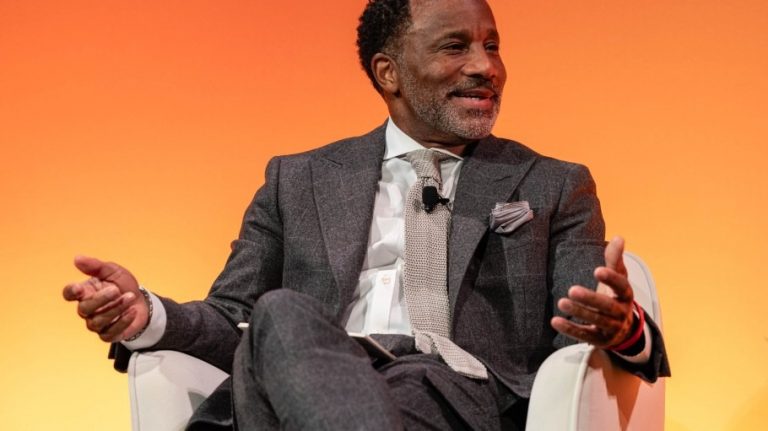The lessons he learned during a year as East Coast sales manager for Ralph Lauren’s women’s collection in the ’90s shaped Jeffrey Tweedy’s career and became the blueprint for the next generation of influential American lifestyle brands.
“Ralph teaches us that whether you buy a $9.99 polo or a $9,000 polo, it’s his shirt that signals a certain lifestyle identity,” Tweedy said during a keynote fireside chat in New York with Sourcing Journal editor-in-chief Jessica Binns. “He stayed true to the consumer. He did what he did best and he stayed consistent.”
Tweedy, co-founder and former CEO of Sean John, the streetwear-turned-lifestyle brand created by Sean “Diddy” Combs, spoke about how he grew the brand’s idea into one of the fastest-growing men’s sportswear brands of the 2000s.
“What I was able to do at Sean John, and why it has been successful for 23 years, is because I used the Ralph Lauren blueprint,” he said. “When I had the opportunity to get into department stores, I used the blueprint of, ‘If 180 square feet works, I want to do 320 square feet.’ We used that same blueprint, and at Macy’s, we were the third-largest real estate owner in men’s for four or five years.”
The FIT grad, who previously held roles at Ralph Lauren and vice president roles at Spike Lee’s Forty Acre Products and Carl Kani, joined Sean John in 1998 when the brand was still a hot topic for the rapper-turned-fashion mogul.
At the time, Tweedy was in talks with Daymond John, now a judge on “Shark Tank,” to join his brand, FUBU, which turned out to be an unexpected turn of events. The New York streetwear label, founded in 1992 by John, Keith Perrin, J. Alexander Martin, and Carl Brown, was weakly organized and in need of higher profit margins. John made the mistake of telling Combs about Tweedy, who quickly convinced Tweedy to take a chance on his vision.
“What was always interesting was [Combs] “He had a great vision for the brand,” Tweedy says. But there was a learning curve. “He didn’t understand the market. He didn’t understand how to make it happen.” Tweedy recalls that Combs thought the brand needed to take all of its inventory to trade shows like MAGIC. “He [buyers] We brought the stock back to the plane.”
As executive president for seven years, Tweedy led the day-to-day operations of the rapidly growing company, overseeing sales, planning and budgets. He also hired the brand’s first designer. Tweedy’s actions catapulted Sean John to become one of the fastest-growing men’s sportswear brands in the United States. The brand was sold in major retailers nationwide and carved out a new niche in the “fashiontainment” market.
In 2007, Tweedy became CEO and served in that role for 14 years, maximizing the brand’s online visibility through engaging content and relationships with brand ambassadors. Tweedy retired from the company in 2021 but continues to serve as a brand advisor.
Combs sold a majority stake in Sean John to brand management company CAA-GBG in 2016. He bought it back in 2021 for $7.55 million in cash.
Sean John was, in a way, a product of its time. According to Tweedy, the ’90s was a special time because digital communication, fashion and music were merging into one huge platform and consumers were willing to try new ideas. Tweedy knew Sean John had touched people’s hearts when E! Entertainment Television broadcast a Sean John runway show live in 2003 and the CFDA named Combs Menswear Designer of the Year in 2004, beating out fashion industry veterans like Michael Kors and Ralph Lauren. Sean John also achieved another feat by becoming the first young African-American male brand to sign a fragrance deal with Estée Lauder.
“We never took the term ‘lifestyle’ for granted,” Tweedy said.
Combs had the vision, but it was up to Tweedy to develop the strategy and build the team that would achieve the company’s goals. His unconventional, transparent approach to hiring and management at Sean John encouraged departments to step out of their silos and learn how other parts of the business worked. If only 2% of a T-shirt design sold, he challenged the designers to look at the data and understand why. [employees] “You have to understand that things will be uncomfortable and it won’t be great coming into the office every day. But I’ve also had fun ensuring we have ‘brand champions’ who speak highly of Sean John wherever we go,” he said.
Tweedy said that while nurturing diverse talent is a passion, more must be done to educate students and fund young talent. By helping students prepare portfolios for fashion school applications, hiring interns that companies are already invested in, and offering practical input on designs that aren’t scalable, the industry needs to ensure diversity doesn’t become a passing fad, Tweedy said.
He added that companies should look inward, identify employees who can manage at the C-suite level, and give them those opportunities.
“Otherwise, they don’t know what to aim for,” he said.


